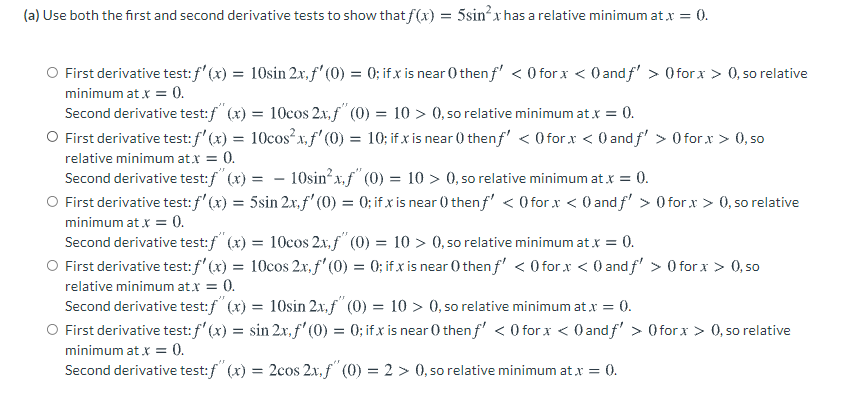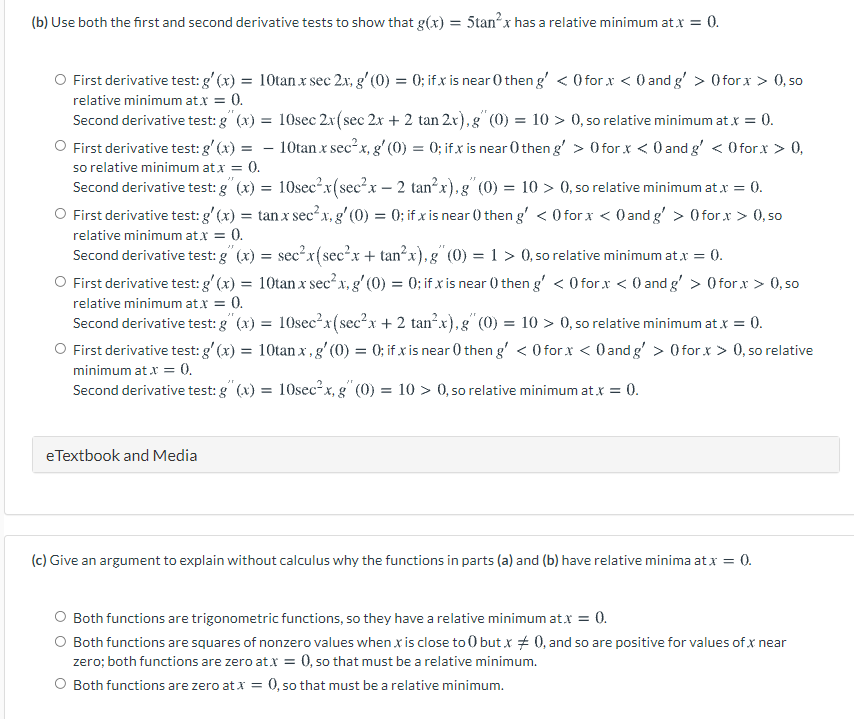(a) Use both the first and second derivative tests to show that f(x) = 5sin²xhas a relative minimum atx = 0. O First derivative test:f' (x) = 10sin 2x.f' (0) = 0; if x is near 0thenf' < 0 for x < 0andf' > O forx > 0, so relative minimum at x = 0. Second derivative test:f"(x) = 10cos 2x.f" (0) = 10 > 0, so relative minimum at.x = 0. O First derivative test:f' (x) = 10cos² x.f' (0) = 10; if x is near 0 thenf' < O forx < 0 and f' > O for x > 0, so relative minimum atx = 0. Second derivative test:f (x) = - 10sin°x.f" (0) = 10 > 0, so relative minimum atx = 0. O First derivative test:f'(x) = 5sin 2x,.f'(0) = 0; if x is near 0 thenf' < O for x < 0 and f' > O for x > 0, so relative %3D minimum at x = 0. Second derivative test:f (x) = 10cos 2x.f" (0) = 10 > 0, so relative minimum atx = 0. O First derivative test:f' (x) = 10cos 2x.f' (0) = 0; if x is near O thenf' < Oforx < 0 and f' > 0 forx > 0, so relative minimum atx = 0. Second derivative test:f (x) = 10sin 2x.f" (0) = 10 > 0, so relative minimum at x = 0. O First derivative test:f' (x) = sin 2x. f'(0) = 0; if x is near 0 thenf' < 0 for x < 0 andf' > Ofor x > 0, so relative %3D
(a) Use both the first and second derivative tests to show that f(x) = 5sin²xhas a relative minimum atx = 0. O First derivative test:f' (x) = 10sin 2x.f' (0) = 0; if x is near 0thenf' < 0 for x < 0andf' > O forx > 0, so relative minimum at x = 0. Second derivative test:f"(x) = 10cos 2x.f" (0) = 10 > 0, so relative minimum at.x = 0. O First derivative test:f' (x) = 10cos² x.f' (0) = 10; if x is near 0 thenf' < O forx < 0 and f' > O for x > 0, so relative minimum atx = 0. Second derivative test:f (x) = - 10sin°x.f" (0) = 10 > 0, so relative minimum atx = 0. O First derivative test:f'(x) = 5sin 2x,.f'(0) = 0; if x is near 0 thenf' < O for x < 0 and f' > O for x > 0, so relative %3D minimum at x = 0. Second derivative test:f (x) = 10cos 2x.f" (0) = 10 > 0, so relative minimum atx = 0. O First derivative test:f' (x) = 10cos 2x.f' (0) = 0; if x is near O thenf' < Oforx < 0 and f' > 0 forx > 0, so relative minimum atx = 0. Second derivative test:f (x) = 10sin 2x.f" (0) = 10 > 0, so relative minimum at x = 0. O First derivative test:f' (x) = sin 2x. f'(0) = 0; if x is near 0 thenf' < 0 for x < 0 andf' > Ofor x > 0, so relative %3D
Calculus: Early Transcendentals
8th Edition
ISBN:9781285741550
Author:James Stewart
Publisher:James Stewart
Chapter1: Functions And Models
Section: Chapter Questions
Problem 1RCC: (a) What is a function? What are its domain and range? (b) What is the graph of a function? (c) How...
Related questions
Question

Transcribed Image Text:(a) Use both the first and second derivative tests to show that f(x) = 5sinxhas a relative minimum at x = 0.
First derivative test:f'(x) = 10sin 2x.f' (0) = 0; if x is near 0 then f' < 0 for x < 0 andf' > Oforx > 0, so relative
%3D
minimum at x = 0.
Second derivative test:/" (x) = 10cos 2x.f" (0) = 10 > 0, so relative minimum at x
O First derivative test:f' (x) = 10cos²x,f'(0) = 10; if x is near () thenf' < O for x < 0 and f' > 0 for x > 0, so
0.
relative minimum at.x = 0.
- 10sin²x,f" (0) = 10 > 0, so relative minimum atx = 0.
Second derivative test:f (x) =
First derivative test: f'(x) = 5sin 2x, f' (0) = 0; if x is near () thenf' < O forx < 0 and f' > 0 for x > 0, so relative
minimum at x = 0.
Second derivative test:f" (x) = 10cos 2x,f" (0) = 10 > 0, so relative minimum at x = 0.
O First derivative test: f' (x) = 10cos 2x, f' (0) = 0; if x is near 0 then f' < 0 for x < 0 andf' > 0 for x > 0, so
relative minimum at.x = 0.
Second derivative test:f" (x) = 10sin 2x,f" (0) = 10 > 0, so relative minimum at x = 0.
O First derivative test: f' (x) = sin 2x. f' (0) = 0; if x is near 0 then f' < O for x < O and f' > Oforx > 0, so relative
minimum at x = 0.
Second derivative test:f" (x) = 2cos 2x, f" (0) = 2 > 0, so relative minimum atx = 0.

Transcribed Image Text:(b) Use both the first and second derivative tests to show that g(x) = 5tanx has a relative minimum at x = 0.
O First derivative test: g' (x) :
= 10tan x sec 2x, g' (0) = 0; if x is near 0 then g' < 0 for x < 0 and g' > O forx > 0, so
relative minimum atx = 0.
Second derivative test: 8 (x) = 10sec 2x(sec 2x + 2 tan 2x), g (0) = 10 > 0, so relative minimum at x = 0.
First derivative test: g' (x) = - 10tan x sec²x, g' (0) = 0; if x is near 0 then g' > O for x < 0 and g' < Oforx > 0,
so relative minimum at x = 0.
Second derivative test: g (x) = 10sec²x(sec?x – 2 tan? x), g (0) = 10 > 0, so relative minimum atx = 0.
O First derivative test: g' (x) = tan x sec²x, g' (0) = 0; if x is near () then g' < O for x < O and g' > O for x > 0, so
relative minimum at.x = 0.
Second derivative test: g (x) = sec?x(sec?x + tan?x),g" (0) = 1 > 0, so relative minimum at.x = 0.
O First derivative test: g' (x) = 10tan x sec?x, g'(0) = 0; if x is near () then g' < 0 for x < 0 and g' > 0forx > 0, so
relative minimum at.x = 0.
Second derivative test: g" (x) = 10sec²x(sec²x + 2 tan?x), g"(0) = 10 > 0, so relative minimum at x = 0.
O First derivative test: g' (x)
minimum at x = 0.
Second derivative test: g (x) = 10sec²x, g" (0) = 10 > 0, so relative minimum at x = 0.
10tan x, g'(0) = 0; if x is near 0 then g' < 0 for x < Oand g' > 0 for x > 0, so relative
%3D
eTextbook and Media
(c) Give an argument to explain without calculus why the functions in parts (a) and (b) have relative minima at x = 0.
O Both functions are trigonometric functions, so they have a relative minimum atx = 0.
%3D
O Both functions are squares of nonzero values when x is close to 0 but x + 0, and so are positive for values of x near
0, so that must be a relative minimum.
0, so that must be a relative minimum.
zero; both functions are zero atx =
Both functions are zero at x =
Expert Solution
This question has been solved!
Explore an expertly crafted, step-by-step solution for a thorough understanding of key concepts.
This is a popular solution!
Trending now
This is a popular solution!
Step by step
Solved in 4 steps

Recommended textbooks for you

Calculus: Early Transcendentals
Calculus
ISBN:
9781285741550
Author:
James Stewart
Publisher:
Cengage Learning

Thomas' Calculus (14th Edition)
Calculus
ISBN:
9780134438986
Author:
Joel R. Hass, Christopher E. Heil, Maurice D. Weir
Publisher:
PEARSON

Calculus: Early Transcendentals (3rd Edition)
Calculus
ISBN:
9780134763644
Author:
William L. Briggs, Lyle Cochran, Bernard Gillett, Eric Schulz
Publisher:
PEARSON

Calculus: Early Transcendentals
Calculus
ISBN:
9781285741550
Author:
James Stewart
Publisher:
Cengage Learning

Thomas' Calculus (14th Edition)
Calculus
ISBN:
9780134438986
Author:
Joel R. Hass, Christopher E. Heil, Maurice D. Weir
Publisher:
PEARSON

Calculus: Early Transcendentals (3rd Edition)
Calculus
ISBN:
9780134763644
Author:
William L. Briggs, Lyle Cochran, Bernard Gillett, Eric Schulz
Publisher:
PEARSON

Calculus: Early Transcendentals
Calculus
ISBN:
9781319050740
Author:
Jon Rogawski, Colin Adams, Robert Franzosa
Publisher:
W. H. Freeman


Calculus: Early Transcendental Functions
Calculus
ISBN:
9781337552516
Author:
Ron Larson, Bruce H. Edwards
Publisher:
Cengage Learning